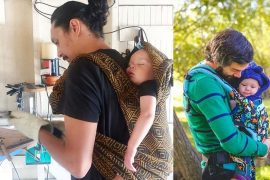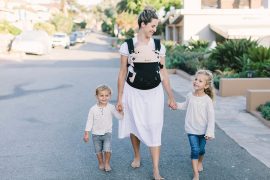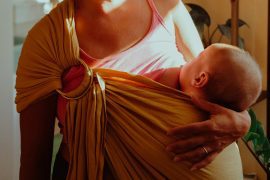By Tracy Cassels
The idea of babywearing being a fad is something I see regularly online and amongst certain groups of parents. It’s somehow seen as a practice that has extended from attachment parenting and thus represents the “hippie” parents who centre their live around their child, or so we are told.
The thing is that it is nothing of the sort.
Babywearing is no fad, but rather a means of keeping an infant in close proximity that is as old as human history. In case this needed saying, there were no strollers or car seats or anything like that thousands of years ago. And of course the safest place for an infant in the wild was on a parent. So you see, we have evolved as a species to have babywearing as a central tenet of our parenting practices.
When I say this though, that also gets some blowback. After all, just because it was useful doesn’t mean it’s good. There are certain advocates of RIE (Resources for Infant Educarers) who believe that babywearing is disrespectful to the infant – treating the infant as an object instead of a person and/or being too constraining for the child to explore their environment. Other people voice concerns that it will impact child development and they won’t learn to walk if they are regularly held.
Needless to say, when we think about how we evolved as a species and the regular use of babywearing as a part of this, we have to consider what this might also mean for the babies whose biology might now expect this type of proximity.
What the Science Says
Lucky for us, there are researchers that have looked at the practice of babywearing with respect to various outcomes. Now, I will first say that the research is still relatively young, with not a whole lot to hang our hats on, but what is there is very interesting.
Needless to say, when we think about how we evolved as a species and the regular use of babywearing as a part of this, we have to consider what this might also mean for the babies whose biology might now expect this type of proximity.
The most common claim – one that is echoed in attachment parenting circles – is that babywearing can help facilitate attachment. Now let’s be clear, this doesn’t mean it’s necessary for attachment, but rather can help it along. And if a simple practice of carrying your baby increases their secure attachment, it may be an easy investment for those who may struggle to engage in other ways that might facilitate attachment or who live in environments that risk attachment. It’s through this lens on attachment that we must look at the research.
Two early studies (Ainsfeld, Casper, Nozyce, & Cunningham, 1990; Hunzinker & Barr, 1986) found positive effects of infant carrying in experimental studies. Hunzinker and Barr found that extended periods of infant carrying (either in arms or in a carrier) between 3 and 12 weeks of age was associated with reduced crying at 6, 8, and 12 weeks of age. Ainsfeld and colleagues used a randomised controlled trial to examine the effect of infant carrying (using a carrier) on high-risk mothers and found an increase in secure attachment at 13 months of age in the babywearing group compared to the control group. In 2018, one study found that babywearing increased communication (including more parent speech, infant vocalisations, dyadic conversations, and infant-led speech) between infants and their caregivers doing the carrying (Mireault, Rainville, & Laughlin, 2018), but this study didn’t include a look at attachment.
More recently, the topic of babywearing has gotten close attention by a group of researchers at Arizona State University led by Dr. Lela Rankin Williams under the larger Mother Baby Bonding Study. With the idea that babywearing can facilitate – but is not necessary for – attachment, they have focused their early work on at-risk mothers, specifically adolescent mothers. Adolescent mothers are more likely to be lower-income, have more difficulties with birth (e.g., lower birth weight, pre-term birth), their infants are more likely to be of a “difficult” temperament, and they are more likely to suffer post-partum depression, all of which place them in the at-risk category (reviewed in Williams, 2020).
Mothers showed greater positive engagement, they were less withdrawn, and importantly they showed greater exaggerated positivity in the reunion phase in order to help facilitate positivity in their infants.
The findings I’m about to provide come from the same study, but different papers (Williams, 2020; Williams & Turner, 2020a). The sample includes 33 infant-adolescent mother dyads who were randomly assigned to either the intervention group – where mothers were asked to use a carrier (provided) for 1 hour per day over 3 months – or the control group – where mothers were given a book set to read to the child daily. Compliance in the intervention group was, on average, 5.9 hours of use per week. The researchers did assess how many control mothers used the carrier on their own accord and around 25% did, but the amount of use was significantly higher in the intervention group.
There are two main findings from the papers to do with the effects of babywearing: the first is to do with the still-face paradigm and the second is to do with attachment security (and is the first study to replicate Ainsfeld and colleagues three decades later). We’ll start with the still-face paradigm (Williams, 2020). There are three phases of the still-face paradigm: engagement, separation, and reunion. In the engagement phase, the infant and mother are interacting normally. In the separation phase, the mother stopped engaging and provided a ‘still face’ that exhibits no emotion or communication. Finally, the reunion phase is when the mother returns to interacting with her infant. Researchers assess the levels of negative and positive displays from both mothers and infants in order to assess the quality of the relationship. What we want to see is that there is high positivity in the engagement phase, negativity in the separation stage, and then back to positivity in the reunion stage – if you were drawing a curve it would look like a U-shape for positivity and an upside-down-U for negativity.
What was found? For starters, the infants in the control group showed greater negativity across all three conditions, suggesting overall their relationship was not as positive. In fact, they did not display the upside-down-U-shape for their negativity, but rather had a linear increase in negativity across the three phases of the paradigm; this means the infants were most negative at reunion. This was mirrored (or led) by maternal engagement that was also less positive than the mothers in the intervention group, especially during the reunion phase.
Infants in the intervention group showed the classic upside-down-U-shape for negativity in that it was low during the engagement and reunion stages and high negativity (higher than the control group) in the separation stage. Mothers showed greater positive engagement, they were less withdrawn, and importantly they showed greater exaggerated positivity in the reunion phase in order to help facilitate positivity in their infants. These maternal behaviours help infants “bounce back” from the negative experience of the separation.











